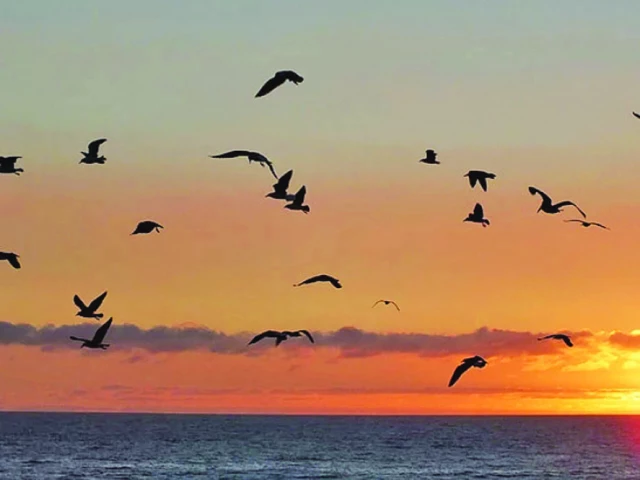KARACHI:
Karachi was as soon as described as one of many world’s nice coastal metropolises, a metropolis the place practically 100 species of native birds might be discovered. Kingfishers perched close to mangroves, sparrows flocked in backyards, and herons moved gracefully throughout wetlands. For older residents, these sightings have been unremarkable, a part of the town’s pure rhythm.
However right this moment, they’re changing into uncommon and the explanations attain deep into the town’s altering panorama. The primary issue, specialists say, is habitat loss. “Removing of timber and pure nesting habitats forces native birds to vacate city areas,” stated Rafi ul Haq, former nationwide coordinator on the Worldwide Union for Conservation of Nature (IUCN) whereas chatting with The Categorical Tribune.
A plant ecologist with many years of expertise, he recalled how guava and mango timber as soon as housed parrots and quails. “Deforestation has left these birds with out the habitat they want for shelter, meals, and laying eggs.”
Shifts in climate patterns have additional deepened the pressure. “Altering local weather and climate patterns in addition to destruction of pure habitat disturb the steadiness that’s wanted for birds to outlive and reproduce,” stated Dr. Harish, avian specialist and veterinarian on the Animals and Birds Care Middle. For a lot of species, even small disruptions to temperature or rainfall cycles can intrude with breeding.
Others emphasise the function of meals sources. “All fowl species depend on a selected habitat for his or her survival, which incorporates timber and a selected eating regimen similar to fruits, seeds, or bugs,” stated Shahzad Qureshi, founding father of City Forest.
“If that habitat is destroyed, there isn’t any place for the birds to nest and no meals for them to eat.” The result’s an unraveling of pure techniques. “Wildlife are sometimes depending on each other for survival. If any piece on this puzzle is eliminated, the entire ecosystem could also be misplaced,” Qureshi added.
In line with the WWF, even frequent species at the moment are in decline. Sparrows, as soon as ample, are quickly reducing, whereas songbirds similar to mynas, larks, and bulbuls are disappearing from city areas. On the identical time, scavengers like crows and kites are multiplying. The development extends throughout fowl households.
“Different species in danger embrace passerine birds like munias and tailorbirds, wading birds similar to herons, egrets, stilts, and sandpipers, and raptors like kites, falcons, owls, and different birds of prey,” stated Zohaib Ahmed, undertaking supervisor at Re-Wilding Indus and a wildlife photographer
“All of those teams are seeing declining numbers attributable to shrinking habitats, diminished meals availability, and human disturbance.” Predation by dominant species compounds the issue. “The excessive inhabitants of home crows in Karachi is without doubt one of the largest threats to smaller native birds,” stated Zohaib.
“Crows raid nests for eggs and chicks, concentrating on species similar to the home sparrow, frequent tailorbird, white-throated munia, and white-browed fantail. They’re additionally able to looking extra human-friendly birds like swifts, martins, and swallows.”
Sparrows, too small to defend themselves, are significantly weak. “Overpopulation of sure fowl species has resulted in a extra aggressive ecosystem,” stated Rafi. “The big variety of kites and crows have made it very laborious for different native fowl species to thrive.”
People can contribute closely to those imbalances, too. “Locations like Kabootar Chowk trigger an inflow of overly giant quantities of 1 kind of fowl, which then makes it tougher for different species to develop their populations,” Rafi stated. “Folks throw leftover meat elements for eagles and crows, which will increase the danger of bacterial an infection outbreaks amongst birds.”
These scraps additionally draw different predators. “Stray canines and cats feed on the leftovers but in addition prey on eggs of ground-nesting birds like lapwings,” Zohaib stated. Rubbish piles present additional gas for crows and kites, strengthening their dominance within the city setting. “Their potential to feed on rubbish and survive in human-modified habitats permits them to thrive whereas native species disappear.”
Proof from exterior Karachi suggests related dynamics. A research performed in Sargodha between November 2010 and March 2011 recorded 2,998 home sparrows and a pair of,619 home crows in rural areas, however in city areas crows outnumbered sparrows – 2,056 to 1,873. Researchers famous that such patterns level to competitors and different stressors shaping sparrow decline.
Consultants then agree that reversing these tendencies requires pressing intervention. “Residents can create bird-friendly areas at dwelling, in colleges, and in neighborhoods,” Zohaib stated. “Place nest containers, present protected water sources, keep away from littering, and take part in clean-up drives in wetlands and inexperienced belts.”
Authorities measures are equally necessary. “Authorities should shield and restore pure habitats similar to wetlands, inexperienced belts, and mangroves, design city wildlife-friendly parks, and use graveyards and open lands as inexperienced sanctuaries.
Wildlife patrolling to forestall poaching, and empowering police and park authorities to behave in opposition to unlawful wildlife commerce, particularly in markets like Empress Market, are important.” stated Zohaib.
Lastly, reforestation provides essentially the most sustainable repair. “Habitat restoration is essentially the most essential issue,” stated Qureshi. “Reforestation mustn’t imply planting only one tree kind, however a number of native species. Totally different timber are dwelling to totally different birds, and solely an equilibrium of all types will restore variety. Dense canopies are significantly necessary as a result of they permit for safe nesting.”
The warnings couldn’t be clearer. Karachi’s birdlife as soon as gave the town its color and track. With out rapid motion to revive habitats and rebalance ecosystems, these sounds could vanish altogether.

